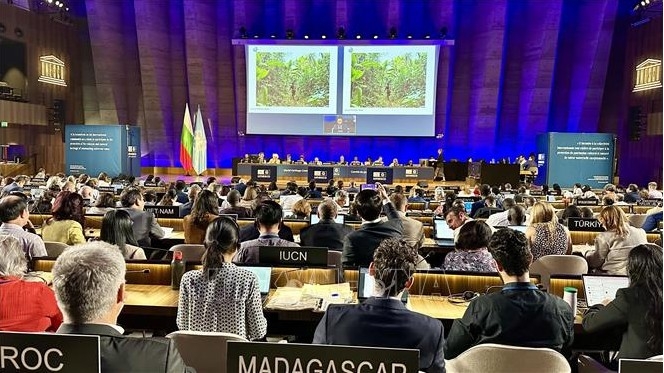First Vietnam–Laos transboundary World Heritage Site stands as testament to enduring friendship
VOV.VN - The recognition of the Phong Nha–Ke Bang and Hin Nam No national parks as a joint World Heritage Site stands as a meaningful symbol of the enduring friendship between Vietnam and Laos.

The UN Educational, Scientific and Cultural Organization (UNESCO) officially recognized the first transboundary Natural World Heritage Site between Vietnam and Laos-“Phong Nha–Ke Bang National Park and Hin Nam No National Park”, during the 47th session of the World Heritage Committee held on July 13 in Paris ,France.
The decision to extend the boundaries of the Phong Nha–Ke Bang World Heritage Site to include Hin Nam No in Khammouane province of Laos, is based on three criteria: geology and geomorphology, ecosystem, and biodiversity.
Deputy Minister of Culture, Sports and Tourism Hoang Dao Cuong described the recognition as a shared achievement of the two countries, indicating the enduring friendship between Vietnam and Laos. He noted that relevant agencies from both sides would continue to work closely together to preserve and promote the heritage values, in parallel with sustainable economic development.
As a locality directly involved in the nomination process, central Quang Tri province appreciated the effective cooperation between the two countries. Vice Chairman of the provincial People’s Committee Hoang Xuan Tan said Phong Nha–Ke Bang had provided strong support to Laos, and that joint management would be implemented more effectively as the two parks are adjacent.
Concerning key tasks in the time ahead, Associate Professor Dr. Le Thi Thu Hien, Director General of the Department of Cultural Heritage, stated: “To effectively manage the transboundary World Heritage Site between Vietnam and the Lao People’s Democratic Republic, both sides need to continue promoting scientific research and developing operational approaches to address potential threats to the heritage.”
She emphasized the need to “assess tourism carrying capacity in line with ecological and resource sustainability across the entirety of Phong Nha–Ke Bang and Hin Nam No national parks.”
Notably, she added that Vietnam could support the Lao side in strengthening its capacity to develop legal frameworks for the management, protection, and promotion of World Heritage values.
In her remarks thanking the World Heritage Committee and international friends for their support, Suansavanh Viyaketh, Minister of Information, Culture and Tourism and Chair of the National Heritage Committee of the Lao PDR, expressed her delight, stating: “Today marks a meaningful day and a proud moment for the Government and the entire Lao society, as Hin Nam No National Park of the Lao PDR has been officially inscribed as an extension of the Phong Nha–Ke Bang World Heritage Site in Vietnam.”
The recognition of this transboundary heritage site is the result of seven years of cooperation between the two countries, beginning with a Memorandum of Understanding signed in 2018. In 2023, the two governments agreed to jointly prepare the nomination dossier.
Minister of Culture, Sports and Tourism Nguyen Van Hung and his Lao counterpart Suansavanh Vignaket held several direct meetings, while the Vietnamese Department of Cultural Heritage worked closely with its Lao counterpart, with active support from Quang Tri province and the Management Board of Phong Nha–Ke Bang National Park.
Phong Nha–Ke Bang and Hin Nam No form one of the most intact limestone karst landscapes and ecosystems in the world, located at the convergence of the Annamite Mountains and the Central Indochina Limestone Belt. This is the largest intact humid tropical karst system on Earth, featuring unique geomorphological formations, including Son Doong and Xe Bang Fai, recorded as the world’s largest caves in terms of diameter and continuity.
The area also preserves important endemic species and is part of the Northern Annamite Rainforest terrestrial ecoregion. Phong Nha–Ke Bang is home to over 2,700 vascular plant species and 800 vertebrate species, while Hin Nam No hosts more than 1,500 vascular plant species and 536 vertebrate species, including the world’s largest leg-span hunting spider, endemic to Khammouane province.
UNESCO’s recognition not only contributes to conservation but also opens up plenty of opportunities for sustainable tourism and livelihoods for local communities on both sides of the border. It sets a precedent for Vietnam to contribute practical experience in managing transboundary World Heritage Sites under the 1972 Convention.
Moreover, this achievement opens up prospects for sustainable tourism development, creating livelihoods for local communities on both sides of the border, while further strengthening the bonds of friendship and solidarity between the peoples of Vietnam and Laos.
To date, Vietnam has nine World Heritage Sites, including two interprovincial ones, Ha Long Bay – Cat Ba Archipelago and the Complex of Yen Tu – Vinh Nghiem – Con Son, Kiep Bac—as well as one transboundary site with Laos “Phong Nha–Ke Bang National Park and Hin Nam No National Park”.
With its nine World Heritage Sites, Vietnam continues to affirm its strong commitment to preserving and promoting the values of its precious cultural and natural heritage, while also demonstrating a spirit of international cooperation in safeguarding the shared heritage of humanity.



